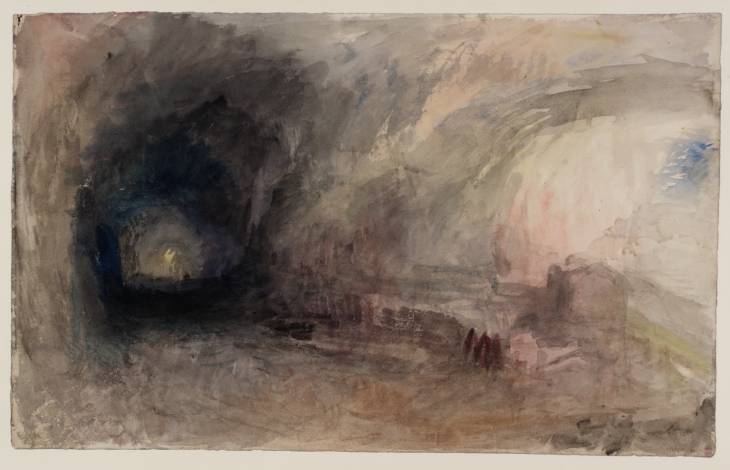Joseph Mallord William Turner A ?French Mountain Pass or Mine c.1826-32
Joseph Mallord William Turner,
A ?French Mountain Pass or Mine
c.1826-32
A ?French Mountain Pass or Mine c.1826–32
D25213
Turner Bequest CCLXIII 91
Turner Bequest CCLXIII 91
Watercolour on white wove paper, 308 x 491 mm
Watermark ‘C Ansell | 1828’
Inscribed in blurred red ink ‘91’ bottom right
Stamped in black ‘CCLXIII – 91’ bottom right
Watermark ‘C Ansell | 1828’
Inscribed in blurred red ink ‘91’ bottom right
Stamped in black ‘CCLXIII – 91’ bottom right
Accepted by the nation as part of the Turner Bequest 1856
Exhibition history
1980
Turner and the Sublime, Art Gallery of Ontario, Toronto, November 1980–January 1981, Yale Center for British Art, New Haven, February–April, British Museum, London, May–September 1981 (80, ‘A Mountain Pass: night (?)’, c.1830).
1987
Watercolours from the Turner Bequest, Tate Gallery, London, April–October 1987 (no catalogue).
2007
Hockney on Turner Watercolours, Tate Britain, London, June 2007–February 2008 (no number, ‘A Mountain Pass’, c.1830, reproduced in colour).
2011
William Turner. Maler der Elemente / Turner and the Elements, Bucerius Kunst Forum, Hamburg, June–September 2011, Muzeum Narodowe, Krakow, October–January 2012, Turner Contemporary, Margate, January–May 2012 (15, as ‘A Mountain Pass’, reproduced).
References
1820
A.J. Finberg, A Complete Inventory of the Drawings of the Turner Bequest, London 1909, vol.II, p.821, CCLXIII 91, as ‘A mountain pass (?). W.M. 1828’, c.1820–1830.
1980
Andrew Wilton, Turner and the Sublime, exhibition catalogue, Art Gallery of Ontario, Toronto 1980, p.164 no.80, as ‘A Mountain Pass: night’, reproduced.
1997
Eric Shanes, Turner’s Watercolour Explorations 1810–1842, exhibition catalogue, Tate Gallery, London 1997, p.97 (Appendix I) under ‘France’, p.98 under ‘Industrial Scenery’.
1830
David Blayney Brown, Turner Watercolours, exhibition catalogue, Tate Britain, London 2007, p.85, as ‘A Mountain Pass’, c.1830, reproduced in colour.
2011
Inés Richter-Musso, Ortrud Westheider and others, William Turner. Maler der Elemente, exhibition catalogue, Bucerius Kunst Forum, Hamburg 2011, p.113 no.15, as ‘A Mountain Pass’, reproduced in colour.
2011
Inés Richter-Musso, Ortrud Westheider and others, Turner and the Elements, exhibition catalogue, Bucerius Kunst Forum, Hamburg 2011, p.113 no.15, as ‘A Mountain Pass’, reproduced in colour.
With its dramatic tonal contrasts, this enigmatic watercolour is dominated by the cave or tunnel on the left-hand side. Deep in its recesses, a light glows. To the right, darker strokes in the foreground might indicate figures, adding a sense of sublime scale to the scene.
The subject and location of this striking but elusive watercolour have long been debated among Turner scholars. One interpretation points to a possible Alpine location. As Napoleon’s troops and engineers developed new time-saving routes by tunnelling through mountain ranges, travel became a safer and more accessible prospect. Spectacular mountain ranges became a destination in their own right, attracting artists and travellers, and the popularity of alpine paintings also increased. Inés Richter-Musso observed how Turner’s encounter with mountain ranges helped him to create a ‘radical pictorial language’, as the monumentality of alpine scenes ‘trained his eye and stimulated his curiosity in the geological processes and elementary forces of nature’.3
Eric Shanes proposed a more industrial theme for this watercolour, suggesting a scene of mineworking in Savoy.4 For comparison, he cited other works in the Turner Bequest, notably Turner’s preparatory study (Tate D27525; Turner Bequest CCLXXX 8) for the watercolour vignette Hannibal Passing the Alps (D27666; CCLXXX 149).5 The latter work appeared in engraved from in Samuel Rogers’s Italy, published in 1830 (Tate impression: T04644). Another strong candidate for comparison is Turner’s watercolour study of wine barrels in a cave (D24831; CCLXI 266), which derives from material he gathered near Saumur on his 1826 tour of the Loire Valley.
In his survey of Turner and the Sublime, Andrew Wilton tentatively connected this study with Turner’s winter travels across Europe.6 Wilton dated it to around 1830, noting that the stark contrast between the darkened tunnel and the area of light was typical of Turner’s work of this period. Yet he also conceded that it was impossible to establish the work’s precise intentions: ‘are we among the wilds of a bleak mountain pass, or is the scene a more familiar one, with streets and houses, and perhaps a torchlit procession?’7 It is difficult to rule out entirely an English or Welsh scene, although, as Wilton noted, ‘no obvious connection suggests itself’.8 There are certain compositional analogies with Turner’s watercolour St Catherine’s Hill, Guildford (Yale Center for British Art, New Haven),9 which also features a tunnel-like recession. It was engraved in 1832 for the Picturesque Views in England and Wales (Tate Impression: T06097).
Alongside Wilton, other scholars have also linked this study to Turner’s interest in the sublime. Richter-Musso observed how Turner’s curiosity for the elements can be seen throughout his oeuvre.10 His understanding of rock formations and erosion stemmed from an awareness of geology and contemporary scientific discourse, and he returned to geological motifs in several works. In this watercolour, Richter-Musso noted, Turner ‘concentrated on the contrast between light and dark, and the transition between the exterior and interior, attempting to create spatial depth using colour’.11 From a technical perspective, he drew influence from the innovative methods of the watercolourist John Robert Cozens (1752–1797), who depicted caves in the Roman Campana, which he visited in 1776 and 1782.12
See the Introduction for general remarks on this grouping of identified and likely French subjects.
Verso:
Blank, apart from a yellow blotch of watercolour at top left. Blind-stamped with Turner Bequest monogram and stamped in black ‘CCLXIII – 91’ bottom left; inscribed in pencil ‘CCLXIII 91’ bottom right, above ‘AB 150 P | O’, and ‘25’ towards centre right, upside down.
Hannah Kaspar
April 2024
How to cite
Hannah Kaspar, ‘A ?French Mountain Pass or Mine c.1826–32’, catalogue entry, April 2024, in David Blayney Brown (ed.), J.M.W. Turner: Sketchbooks, Drawings and Watercolours, Tate Research Publication, November 2024, https://www

